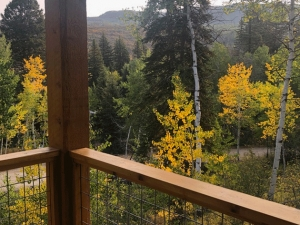by Karen Telleen-Lawton, Noozhawk Columnist (read the original in Noozhawk by clicking here)
I’m home exchanging in the mountains east of Provo, Utah, watching the arrival of autumn. Working on my laptop on an upstairs deck, I’m surrounded by a forest of aspen. The leaves are quaking like dangling earrings. Maybe 20 percent have turned gold; a half-dozen in front of me are mid-morph.
Witnessing the rhythm of the seasons can be deceptive: it lulls you into believing all is right with the world. But it’s not.

The aspen leaves are changing in Utah Mountains. (Karen Telleen-Lawton)
In 2010, nearly 200 countries labored to design a plan to save the Earth’s ecosystems in the subsequent decade. A new United Nations’ Global Biodiversity Outlook report reveals that we failed on every one of the 20 goals.
The Aichi Biodiversity Targets were oriented toward conserving the world’s biodiversity, promoting sustainability, and protecting ecosystems. On the whole, the report card shows Earth’s living systems are acutely suffering.
“The more humanity exploits nature in unsustainable ways and undermines its contributions to people, the more we undermine our own well-being, security and prosperity,” warns Elizabeth Maruma Mrema, executive secretary of the UN’s Convention on Biological Diversity.
In the report, UN Secretary-General Antonio Guterres describes the COVID-19 epidemic as an illustration of “the link between our treatment of the living world and the emergence of human disease.”
A sliver of good news: progress has been achieved with six of the targets. Invasive species are being thwarted in some attempts to become established; conservation areas continue to be maintained. Countries are sharing and benefiting from new knowledge in genetics and biodiversity strategies. Resources are increasingly being mobilized into action plans.
Nevertheless, we’re facing a multi-headed giant. In Santa Barbara’s tiny corner of the planet, we face increasing wildfire frequency and ocean acidification, among other challenges. The Swiss have resorted to covering the edge of their Rhone Glacier with huge white fleece blankets in an attempt to slow its melting.
Ground-zero Greenland is warming twice as fast as the rest of the planet. Their melting ice sheet is the largest land-based contributor to the rising sea levels. Bangladesh, recently ranked as the country most vulnerable to climate change, endures flooding, rising sea levels, cyclones, and landslides amid poverty and weak institutions.
Habitat, biodiversity loss, and environmental degradation remain the biggest enigmas. The Aichi Report also points to a failure to include indigenous communities as stakeholders and deep knowledge bases.
The actions outlined will require hundreds of billions of dollars in annual budgeting globally. Experts say this is a small price compared to the cost of continuing on our present course.
Our collective accomplishments to date show that intergovernmental action is possible. Leadership at the top is essential, especially on the part of developed nations. There’s a plan for it: international treaties such as the Paris Climate Change Agreement outline detailed necessary actions.
The current U.S. administration is in the process of withdrawing from this agreement, but we have the chance to change this trajectory in November. When we know better, we do better.
At the end of our stay, the half dozen leaves I monitored have morphed from green splotched with gold to gold with traces of green, like the old children’s book “Harry the Dirty Dog.” I estimate the forest is now 40% gold in mid-September. The timing of seasons may be in flux, but their reliability is still reassuring.
Karen Telleen-Lawton, Noozhawk Columnist
Karen Telleen-Lawton is an eco-writer, sharing information and insights about economics and ecology, finances and the environment. Having recently retired from financial planning and advising, she spends more time exploring the outdoors — and reading and writing about it. The opinions expressed are her own.


